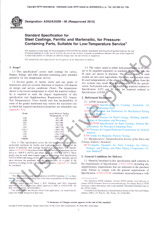We need your consent to use the individual data so that you can see information about your interests, among other things. Click "OK" to give your consent.
ASTM D7904-21
Standard Test Method for Determination of Water Vapor (Moisture Concentration) in Natural Gas by Tunable Diode Laser Spectroscopy (TDLAS)
Translate name
STANDARD published on 1.11.2021
The information about the standard:
Designation standards: ASTM D7904-21
Publication date standards: 1.11.2021
SKU: NS-1041757
The number of pages: 6
Approximate weight : 18 g (0.04 lbs)
Country: American technical standard
Category: Technical standards ASTM
The category - similar standards:
Annotation of standard text ASTM D7904-21 :
Keywords:
moisture concentration, natural gas, TDL, TDLAS, tunable diode laser absorption spectroscopy,, ICS Number Code 75.060 (Natural gas)
Additional information
| Significance and Use | ||||||||||||
|
5.1?Moisture measurement in natural gas is performed to ensure sufficiently low levels for gas purchase contracts and to prevent corrosion. Moisture may also contribute to the formation of hydrates. 5.2?The significance of applying TDLAS for the measurement of moisture in natural gas is TDLAS analyzers may have a very high degree of selectivity and minimal interference in many natural gas streams. Additionally, the sensing components of the analyzer are not wetted by the natural gas, limiting the potential damage from corrosives such as hydrogen sulfide (H2S) and liquid contaminants such as ethylene glycol or compressor oils. As a result, the TDLAS analyzer is able to detect changes in concentration with relatively rapid response. It should be noted that the mirrors of a TDLAS analyzer may be fouled if large quantities of condensed liquids enter the sample cell. In most cases the mirror can be cleaned without the need for recalibration or realignment. 5.3?Primary applications covered in this method are listed in 5.3.1 5.3.3. Each application may have differing requirements and methods for gas sampling. Additionally, different natural gas applications may have unique spectroscopic considerations. 5.3.1?Raw natural gas is found in production, gathering sites, and inlets to gas-processing plants characterized by potentially high levels of water (H2O), carbon dioxide (CO5.3.2?Underground gas storage facilities are high-pressure caverns used to store large volumes of gas for use during peak demand. Underground storage caverns can reach pressures as high as 275 bar. Multistage and heated regulator systems are usually required to overcome significant temperature drops resulting from gas expansion in the sample. 5.3.3?High-quality sales gas is found in transportation pipelines, natural gas distribution (utilities), and natural gas power plant inlets. The gas is characterized by a very high percentage of methane (90 to 100 %) with small quantities of other hydrocarbons and trace levels of contaminates. |
||||||||||||
| 1. Scope | ||||||||||||
|
1.1?This test method covers online determination of vapor phase moisture concentration in natural gas using a tunable diode laser absorption spectroscopy (TDLAS) analyzer also known as a TDL analyzer. The particular wavelength for moisture measurement varies by manufacturer; typically between 1000 and 10 000 nm with an individual laser having a tunable range of less than 10 nm. 1.2?Process stream pressures can range from 700-mbar to 700-bar gage. TDLAS is performed at pressures near atmospheric (700- to 2000-mbar gage); therefore, pressure reduction is typically required. TDLAS can be performed in vacuum conditions with good results; however, the sample conditioning requirements are different because of higher complexity and a tendency for moisture ingress and are not covered by this test method. Generally speaking, the vent line of a TDL analyzer is tolerant to small pressure changes on the order of 50 to 200 mbar, but it is important to observe the manufacturers published inlet pressure and vent pressure constraints. Large spikes or steps in backpressure may affect the analyzer readings. 1.3?The typical sample temperature range is -20 to 65 ?C in the analyzer cell. While sample system design is not covered by this standard, it is common practice to heat the sample transport line to around 50 ?C to avoid concentration changes associated with adsorption and desorption of moisture along the walls of the sample transport line. 1.4?The moisture concentration range is 1 to 10 000 parts per million by volume (ppmv). It is unlikely that one spectrometer cell will be used to measure this entire range. For example, a TDL spectrometer may have a maximum measurement of 1 ppmv, 100 ppmv, 1000 ppmv, or 10 000 ppmv with varying degrees of accuracy and different lower detection limits. 1.5?TDL absorption spectroscopy measures molar ratios such as ppmv or mole percentage. Volumetric ratios (ppmv and %) are not pressure dependent. Weight-per-volume units such as milligrams of water per standard cubic metre or pounds of water per standard cubic foot can be derived from ppmv at a specific condition such as standard temperature and pressure (STP). Standard conditions may be defined differently for different regions and entities. The dew point can be estimated from ppmv and pressure. Refer to Test Method D1142 and ISO 18453. 1.6?UnitsThe values stated in SI units are to be regarded as standard. No other units of measurement are included in this standard. 1.7?This standard does not purport to address all of the safety concerns, if any, associated with its use. It is the responsibility of the user of this standard to establish appropriate safety, health, and environmental practices and determine the applicability of regulatory limitations prior to use. 1.8?This international standard was developed in accordance with internationally recognized principles on standardization established in the Decision on Principles for the Development of International Standards, Guides and Recommendations issued by the World Trade Organization Technical Barriers to Trade (TBT) Committee. |
||||||||||||
| 2. Referenced Documents | ||||||||||||
|
We recommend:
Updating of laws
Do you want to be sure about the validity of used regulations?
We offer you a solution so that you could use valid and updated legislative regulations.
Would you like to get more information? Look at this page.




 Cookies
Cookies
